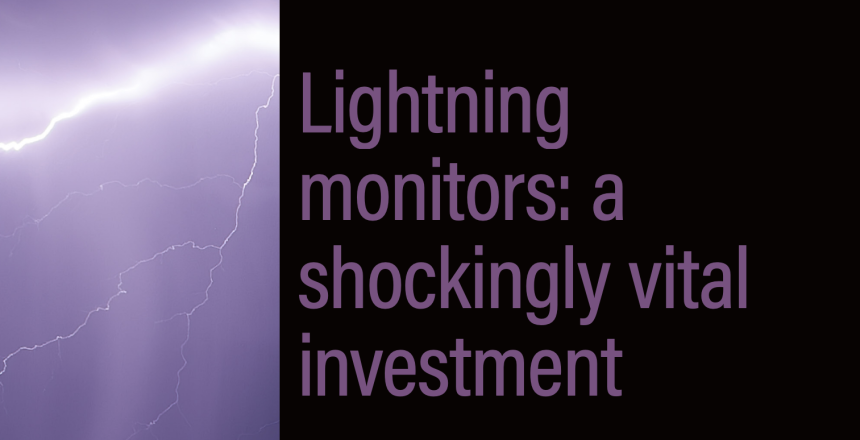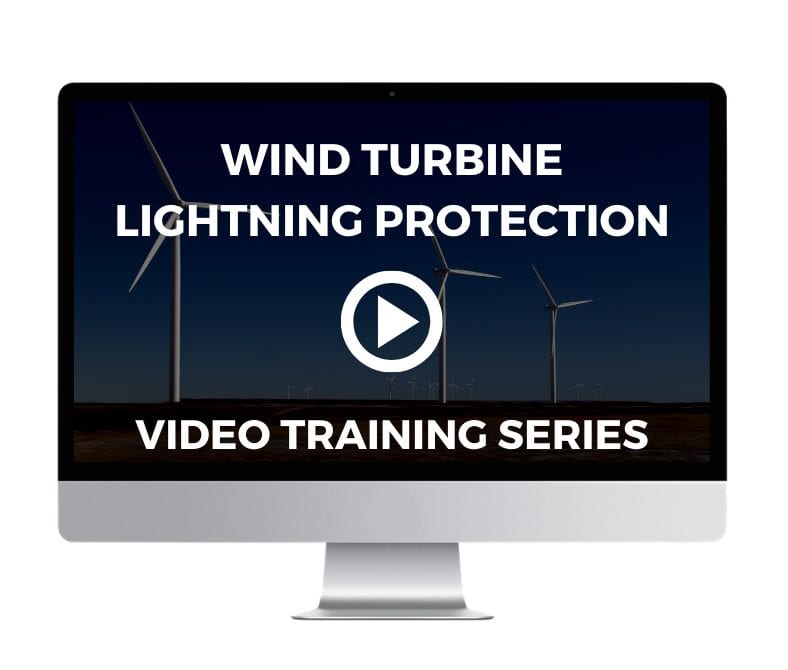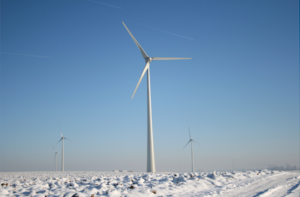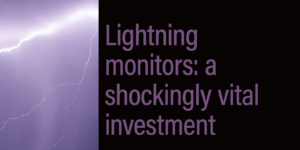This article on wind turbine lightning protection by Allen Hall, President, Weather Guard Lightning Tech, was originally published in PES Wind, Issue 3, 2023.
This year’s lightning season in the northern hemisphere is thankfully ending. Early reports from the field indicate that a significant proportion of lightning strikes caused blade damage. One disturbing fact is becoming clear: there is a tremendous lack of knowledge about which types of lightning strikes are creating damage. Nor is there a significant amount of data on the relative success or failure of OEM blade lightning protection systems. Owners and operators are left to fend for themselves in a scrum of specifications, manuals, and industry standards.
Technology has not penetrated this problem with enough force or rigor. Lightning researchers have conducted valuable, but limited, scope assessments of lightning strikes to turbines. These research efforts have provided useful insights. We now know that upward lightning strikes are prevalent, particularly as wind turbine heights grow. We also have incredible video of lightning following blades through more than 180 degrees in rotation, and we can see the resulting damage. But wind turbine heights have extended faster than research. Most lightning research on turbines was conducted on machines 2 MW and smaller. Plus, the locations of these now miniscule turbines hadn’t expanded to the remote and offshore sites that are commonplace today.
Even in our small state of Massachusetts in the US, wind turbines that once drew little to no lightning are now consistently taking strikes. These turbines exist in the storm cloud layer, closer to pockets of electrical charge, where they are easy targets for convective storms and strikes.
Expand this small sample in Massachusetts to wind turbine operations in the US as a whole. On smaller farms, lightning typically strikes the front or trailing edge of the farm, based on wind direction. The middle areas of the smaller farms can be somewhat immune to lightning strikes, significantly lowering the exposure of owners and operators to lightning issues. Upgrading the LPS of turbines in particular segments of the farm could reward operators with drastic reductions in blade repair budgets.
Larger farms are more likely to have lightning damage throughout the site. No doubt this is a confusing result for operators with a combination of large and small farms. Larger farms will have the added complexity of a variety of blade lengths and turbine heights to maximise the power production at the site. Hub height and blade lengths definitely influence the number of lightning strikes to a blade.
Owners and operators trying to understand how lightning is attacking their farms have a difficult task. The simplest first step is to access Lightning Location Service (LLS) data. These services use a phalanx of lightning sensors to triangulate a likely lightning location while interpolating the current waveform parameters. The location accuracy of the LLS is generally 50m to 150m for negative cloud-to-ground strikes, depending on the type of service. This is remarkably good considering the complexities involved with measuring lightning strikes.
The difficulty is that the LLS cannot identify which strikes hit a turbine. The IEC 61400-24 standard describes the lightning collection area of a single turbine as a circle with a radius of 3 x the turbine tip height. This rule-of-thumb is applied to the LLS strike locations to roughly identify likely strikes to the turbine. However, for very tall modern turbines, the rule of thumb is less accurate. Lightning location services are very accurate when locating the strike in typical cloud-to-ground events since they tend to be mainly vertical discharges. Lightning strikes to tall objects are much more complex than lightning strikes to Earth. Lightning that is initiated from the turbine, so-called upward lightning, doesn’t necessarily travel in a straight upward path to the clouds. In many cases, upward lightning takes a long irregular path to the clouds, which confounds the LLS’s ability to identify a lightning strike location.
Upward lightning from turbines can also produce multiple lightning channels. These odd-looking strikes are called slow upward lightning strikes. One or more of the channels can carry lightning energy to the turbine, which induces errors in the LLS due to simultaneous complex discharges. High-energy thunderstorms contain massive amounts of electrical charge that produce complex lightning pathways. Lightning can travel below the cloud layer horizontally for kilometers before finding a pathway toward Earth.
When two large storms meet, which is very common in the middle of the U.S., the interaction between storms also produces horizontal discharges with the occasional discharge to Earth. An LLS also finds it hard to identify the ground attachment location of these discharges with high accuracy. Thankfully, technological advancements have produced a more effective method for identifying strikes to a specific turbine.
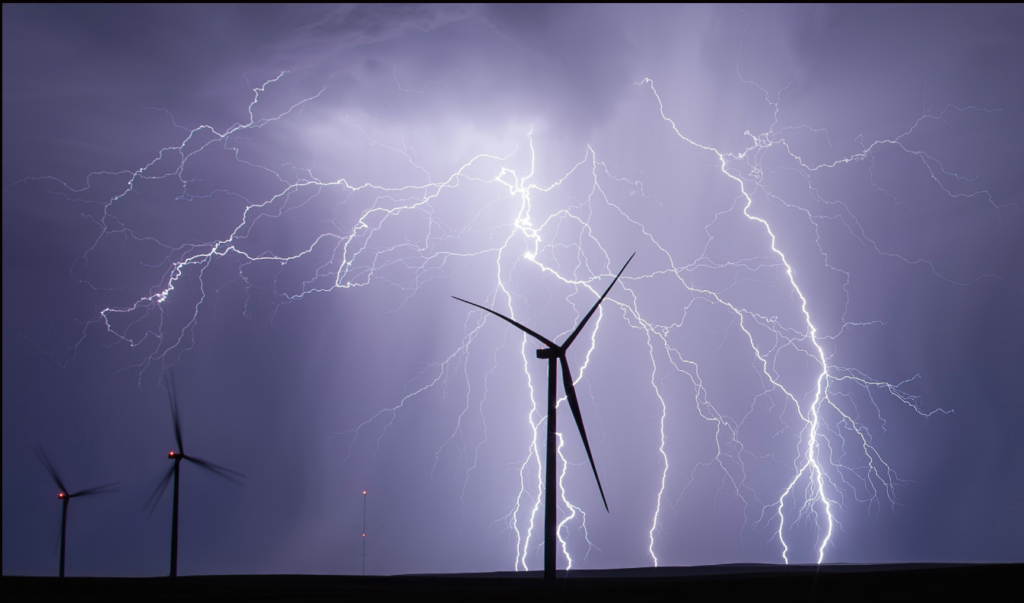
This year eologix-Ping introduced a simple, wireless, and low-cost lightning sensor that mounts near the base of the turbine tower. This lightning sensor has been rapidly deployed across the world to operators seeking more accurate and actionable data on lightning strikes to their turbines. The eologix-Ping sensor records the time a strike occurred and transmits the recorded time to cloud-based servers. The sensor also listens for audible changes to the blade airflow patterns to detect and report lightning damage.
The initial feedback and actionable data from the eologix-Ping lightning sensor deployment have been astounding. Lightning strikes are occurring at a much higher rate than initially predicted by the IEC 61400-24 standard. Depending on location, turbines are taking multiple strikes within days, placing added stress on the LPS. The old assumption of one lightning strike per turbine per year is wildly wrong. Polytech A/S research from 2022 of highly instrumented turbines also points to higher incidences of lightning strikes depending on the turbine location in the world.
The LLS comparisons of strike locations compared to strikes recorded on instrumented towers are also remarkable. Roughly 30% to 40% of strikes in early data are outside of the 3 x tip height area criteria and would likely not be identified by this method. This creates a conundrum for wind turbine technicians. If the LLS data isn’t precise, does every turbine need to be inspected? Should all turbines be shut down until inspections are complete? In most cases, technicians cannot inspect every turbine after every storm, and so the farm continues to operate with lightning damage. Annual drone inspections detect lightning damage, but it is much more expensive to fix than if it were caught and corrected shortly after the strike. The 30% to 40% of strikes being recorded outside of 3 x tip height area are likely due to the high frequency of upward lightning events from turbines. Polytech A/S researchers indicate that upward lightning is now the predominant type of turbine strike. EologixPing sensors have even documented multiple simultaneous upward lightning events from wind farms, typically the result of massive storms overhead.
The simultaneous upward lightning events are visually amazing, but terrible for wind turbine LPS. What is needed at this juncture?
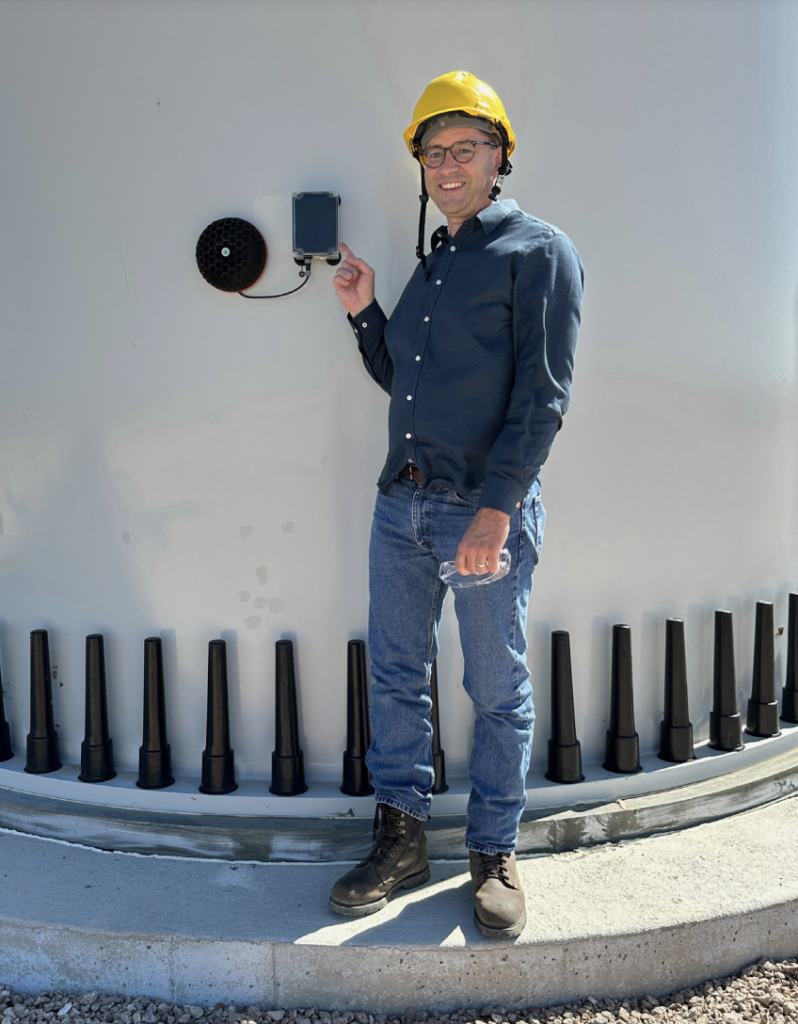
The few turbines that have been instrumented provide researchers with a tiny sampling of the lightning issues for wind turbines. Many more turbines need to be instrumented, and quickly, for OEMs to have sufficient data to properly protect their turbines from the oncoming wrath of lightning. Instrumenting 10% of the worldwide fleet with affordable eologix-Ping lightning sensors is an achievable goal. The sensors need to be deployed across whole farms, particularly in the farms with over 100 turbines, as these larger farms are changing the way lightning storms behave. The sensors also need to be distributed across the lightning hotbeds of the world: Japan, Italy, Greece, Indonesia, the Balkans, Uruguay, Brazil, the American Midwest, and most offshore wind farms.
Is there a place for LLS in the wind industry? Absolutely! The LLS provides highly accurate data on lightning strike times, amplitudes, polarity, durations, and deposited energy. This information is valuable when dealing with warranty or insurance claims. With time stamp information from the eologix-Ping sensor, the LLS information for a strike can be assigned to a turbine. This simple process provides actionable information when inspecting a turbine and determining the next steps.
Wind energy is being deployed in some of the most active lightning-prone areas of the world. Ensuring OEMs, owners, operators, technicians, and insurance companies have sufficient data and knowledge to properly protect their turbines is vital to the energy transition. A simple measure like installing lightning sensors on turbines will rapidly impact the way we respond to lightning strikes and prevent damage in the future.
Mentioned in this article:
StrikeTape https://weatherguardwind.com/striketape/
eologix-Ping https://www.eologix-ping.com/en/
Polytech https://www.polytech.com/
Previous articles by Allen Hall in PES Wind Magazine:
Counting the Cost of Lightning Protection
Lightning Behavior: What We’re Missing in Blade Protection
Listen to the weekly Uptime Wind Energy Podcast to stay up-to-date with the latest technology and wind industry news!

